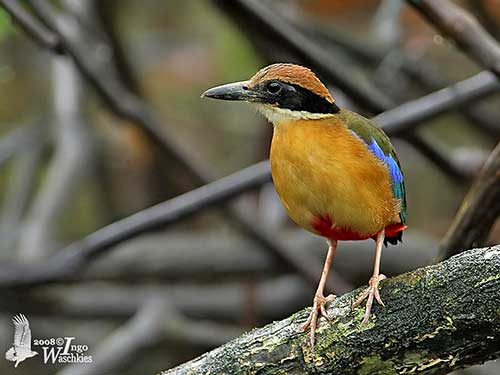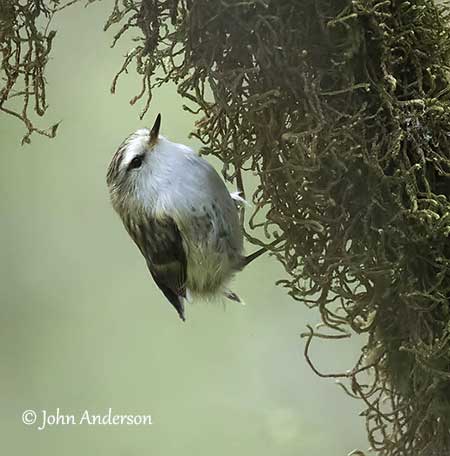
TO BE CONTINUED... Page 3
Text by Nicole Bouglouan
Photographers:
John Anderson
John Anderson Photo Galleries
Jean-Claude Billonneau
Photographe-témoin de la Beauté du Monde
Patrick Ingremeau
TAMANDUA
Rod Morris
Courtesy of Department of Conservation Te Papa Atawhai, 1975
Department of Conservation
William Price
PBase-tereksandpiper & Flickr William Price
Dubi Shapiro
Dubi Shapiro Photo Galleries
Alan & Ann Tate
AA Bird Photography
Ingo Waschkies
Bird Photography
These images and the text are subject to copyright and cannot be used without express authorization from the owners. Legal issues
Sources:
HANDBOOK OF THE BIRDS OF THE WORLD Vol 8 By Josep del Hoyo-Andrew Elliott-David Christie - Lynx Edicions - ISBN: 8487334504
HANDBOOK OF THE BIRDS OF THE WORLD Vol 9 - by Josep del Hoyo - Andrew Elliot - David Christie - Lynx Edicions - ISBN: 8487334695
KNOW YOUR NEW ZEALAND BIRDS by Lynnette Moon - New Holland Publishers – ISBN: 1869660897
BIRDS OF SOUTH AMERICA – Passerines - by Robert S. Ridgely and Guy Tudor – HELM Field Guides – ISBN: 9781408113424
A GUIDE TO THE BIRDS OF COLOMBIA by Steven L. Hilty and William L. Brown - Princeton University Press – ISBN 069108372X
The Birds of Africa: Volume VIII: The Malagasy Region: Madagascar, Seychelles, Comoros, Mascarenes - Par Roger Safford, Frank Hawkins – ISBN: 1408190494, 9781408190494- Editeur: A&C Black, 2013
Te Ara – The Encyclopedia of New Zealand
Wikipedia, the free encyclopaedia
Animal Diversity Web (University of Michigan Museum of Zoology)
THE AVIANWEB - Beauty of Birds (Sibylle Faye)
Asity - From Wikipedia, the free encyclopedia
Creagus – ASITIES – Philepittidae
From Wikipedia, the free encyclopedia - Pittidae
The bird and its nest, where everything starts…
Second part: The Passerines – Order Passeriformes
Page 2: Acanthisittidae, Sapayoidae, Eurylaimidae and Pittidae
At the beginning of the breeding season and following several courtship displays, the nest-site is selected by the pair, or one of the members of the pair, and the nest is built within this area. For numerous species, the nest is the place where displays and copulation occur. It plays a very important role during the nesting period. It is the cradle of the chicks, the place where the adults feed them prior to their first flight towards independence.
The family Acanthisittidae includes at least seven species, formerly with five genera, but today, only four are accepted, Acanthisitta, Xenicus, Pachyplichas and Dendroscansor.
These tiny passerines are regarded as one of the oldest living groups of the New Zealand endemic bird species, and they may be older even than the Kiwis.
In spite of numerous studies of fossil bones found in some cave sites and in deposits accumulated by avian predators, the true relationships of this family have remained unclear for long time. The New Zealand wrens are surviving species of an ancient lineage of passerines with no close living relatives. They are not at all closely related to the true wrens.
There are two surviving species, the Rifleman (Acanthisitta chloris), locally common or widespread according to the range, and the New Zealand Rockwren (Xenicus gilviventris) listed as Vulnerable. Both are still present in New Zealand but they are patchily distributed throughout the country.

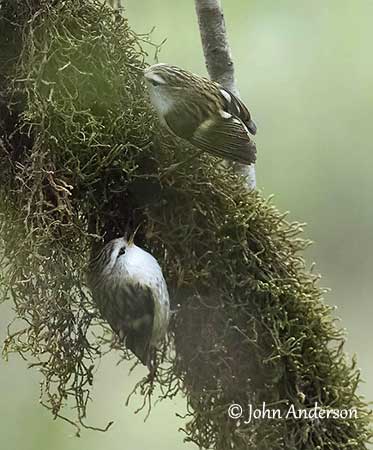
The Rifleman frequents forests and scrub, and is usually found in the larger remaining tracts of forest. The race “chloris” occurs on South Island and Codfish Island, whereas the race “granti” is found on North Island.
The New Zealand Rockwren occurs in alpine and subalpine areas on South Island.
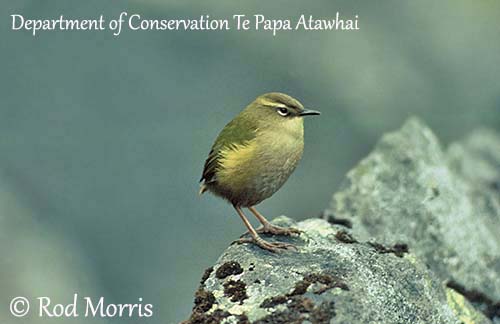
Each species shows some peculiar morphological features, adapted to behaviour and habitat. Their common feature is the pale buff to creamy-white supercilium conspicuous in all species. Upperparts are darker than underparts.
All were probably mainly insect-eaters, but taking occasionally and seasonally seeds, berries and fruits. They forage alone or in pairs, or in family groups.
As weak fliers or flightless birds, the New Zealand wrens are sedentary. Even the New Zealand Rockwren which lives in alpine and subalpine areas does not move in winter.
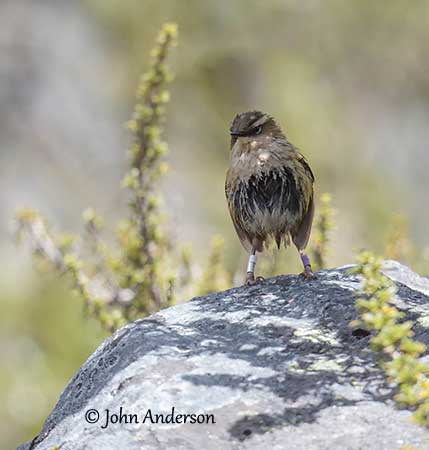
Male with brood patch
Considering that these birds are weak fliers or were flightless, they remain near or on the ground when nesting. The nest is made in natural cavities, often holes in tree trunk or branches, but also among roots, in rock crevices or holes in the ground. The nest is often spherical and built in the cavity. It is made with grass, twigs, moss and rootlets. The inner part is lined with feathers.
The Rifleman’s enclosed, spherical nest is usually built in small cavities in trees or under bark, among rocks or in crevices in cliffs. The nest is made with woven dry grass, twigs, moss and rootlets. Inside the nest, the lining is made with soft grasses and feathers.
Both sexes of New Zealand Rockwren build a fully enclosed bulky nest with side tunnel entrance in natural cavity, usually on or near the ground, or in crevice between rocks, or among roots, or they excavate a nest-hole in the soil. The inner part of the nest is covered with a thick lining of feathers. The nest is made with dry grass, moss, pieces of leaves and tussock.
After about three weeks of incubation, the chicks hatch and the pair feeds them with insects. They fledge between 23-25 days after hatching, but they remain dependent on adults for food during some weeks more. After the breeding season, the juveniles may disperse short distances.
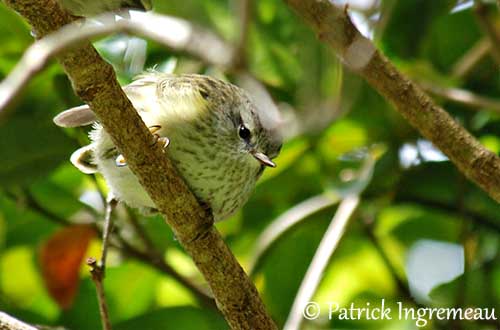
Immature Race "granti"
The family Sapayoidae has only one member, the Sapayoa or Broad-billed Sapayoa (Sapayoa aenigma).
It was previously part of families Pipridae (manakins) or Tyrannidae (flycatchers, tyrants and allies), but recent genetic studies based on various features indicate that it is closest to broadbills (Eurylaimidae) and Philepittidae (asities). It is now placed in its own family, the Sapayoidae.
The Sapayoa is an uncommon species found in the lower growth of humid forest in W Colombia and NW Ecuador, up to 1,100 metres of elevation. It is also present in Panama.
It has uniform olive plumage with darker wings and tail, and semi-concealed yellow coronal patch. It has a broad, flat bill, giving the bird its other name “Broad-billed Sapayoa”.
It is usually seen alone, and less often in pairs, but it regularly joins mixed-species foraging flocks. It feeds primarily on small fruits and insects. It hunts from perches, scanning the nearby foliage before to sally abruptly. Insects are caught in the air and from vegetation.
It breeds between February and April in Colombia and between March and July in Panama. The nest is pear-shaped, with pointed top and rounded bottom. It is made with long pieces of fibrous bark, and long, loose fibrous strands can be seen hanging below. There is a side entrance near the bottom, protected and covered by a kind of “hood” made with vegetal fibres. This structure is suspended from a branch of tree, about two metres above a forest stream.
The female lays two eggs. The chicks appear to be attended by both parents, but two immature males have been observed helping the parents to feed them.
The Sapayoa is suspected to be resident and the species is not globally threatened.
The family Eurylaimidae includes now the broadbills and the more recently added asities.
The broadbills are found in Afrotropical and Oriental regions, where they frequent lowland to montane forests and open woodland, but they sometimes extend to cultivated fields and other more open areas.
These arboreal species are small to medium-sized birds with broad head and large eyes, but the main feature giving the species its name, is the broad, flat, hooked bill with a large gape.
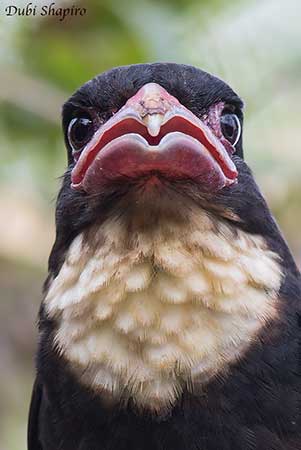
The plumage is strikingly patterned with bright green, blue, maroon or yellow in male, usually duller in females.
Male and female differ slightly in appearance but this feature varies according to the species. The Silver-breasted Broadbill shows slight sexual dichromatism. Male and female are almost similar, but the female shows a narrow, often broken, silver breast collar.
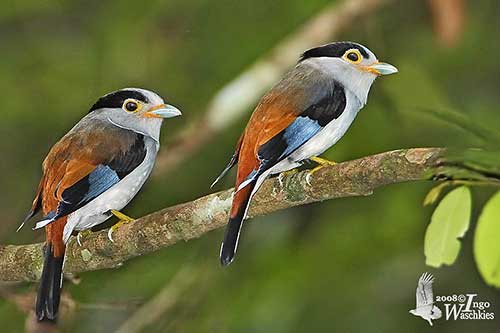
Silver-breasted Broadbill
Female on the left
Most of them feed on insects, lizards and tree-frogs. They hunt from perch, sallying to catch the prey in flight, or gleaning food items off the vegetation while in the air. The broad bill is well adapted to this feeding behaviour.
However, the three species of genus Calyptomena and the Grauer’s Broadbill of genus Pseudocalyptomena feed primarily on fruits, but they also take insects. These four species have smaller bills but they still have wide gape allowing them to swallow the fruit whole.
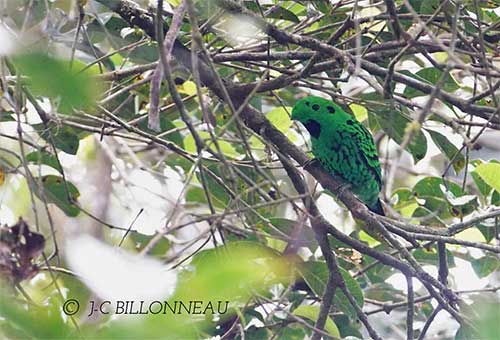
Numerous Eurylaimidae are gregarious and often occur in small flocks. The Dusky Broadbill usually lives in groups on 10-20 individuals, but several other species have the same behaviour.
Broadbills are generally monogamous, although there is some evidence of possible polygyny by the Green broadbills in Asia, and the species of genus Smithornis in the Afrotropics, whereas others may be cooperative breeders. The courtship displays highlight the colourful beauty of their plumage while the birds are moving and singing.
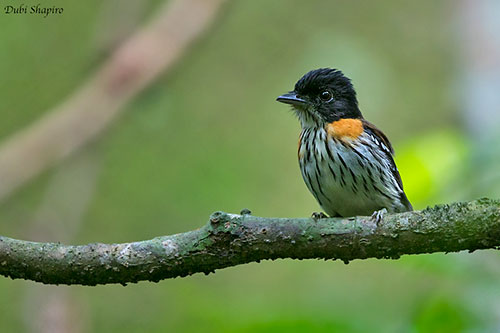
They build woven, pear-shaped nests suspended from tips of tree branches or other conspicuous sites. These structures can be suspended over forest clearings, but also above rivers and streams, or even above roads, paths or ditches, and also in mangroves. The nest is placed between 1 and 30 metres above the ground, but more usually between 3 and 10 metres.
The nests can be placed within the canopy foliage, or in thorny trees or near bees’ nests or wasps’ nests. This practice is suspected to provide an effective protection against predators such as mammals and reptiles.
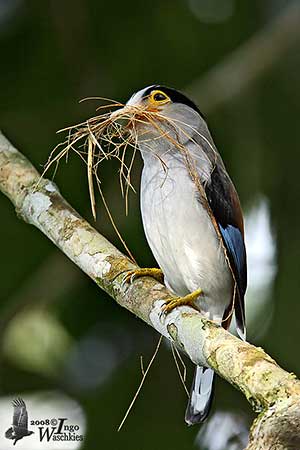
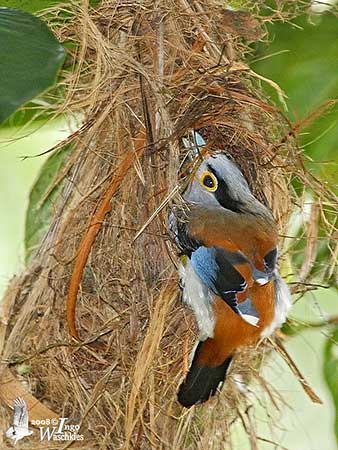
The structure resembles a pear, a bag, a gourd, a ball or a dome. The Green Broadbill builds a gourd-shaped nest attached across branches, not suspended from the tip of a branch. The entrance hole is at the side, and can be concealed by a porch. A drooping “tail”, sometimes relatively long, can be added as ornament. This “tail” provides a good camouflage among the vegetation hanging from trees. Some other decorative material such as lichen, green moss, egg cases of spiders, caterpillar excreta and cocoons, are held together by cobwebs, stems or tendrils.
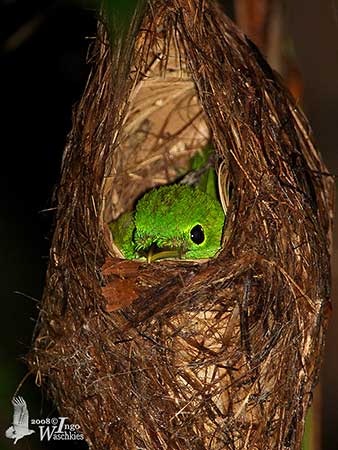
The clutch may range from 1 to 8 eggs, but only 2-3 young are usually raised. The incubation lasts 17-18 days and is probably performed by the female alone. The young fledge 22-23 days after hatching.
The nests of the broadbills are probably the hosts of several species of parasitic cuckoos (Cuculidae), but more information is required.
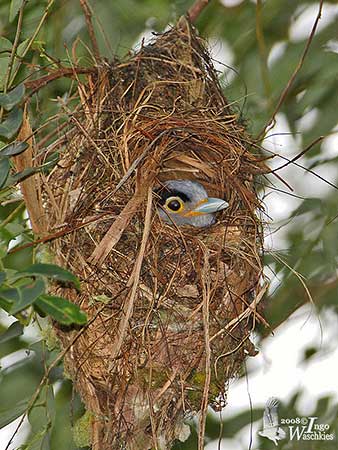
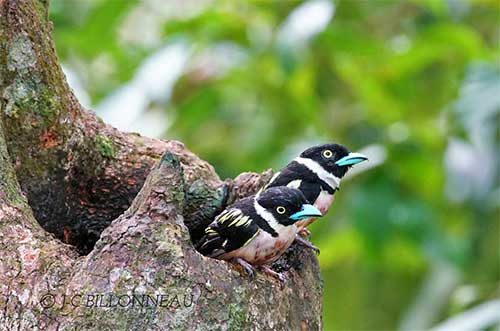
The family Philepittidae (asities) is endemic to Madagascar. After travelling around the taxonomy of the bird’s world, these small birds with amazing form and coloration are today included in the family Eurylaimidae (broadbills).
With two genera (Neodrepanis and Philepitta) and four species, this small family includes strongly sexually dichromatic species with breeding and non-breeding male plumages. The males of all species have conspicuous bright blue and green wattles or caruncles, usually enlarged during the displays, whereas the females show drab olive-green to yellow plumages and lack the ornaments.
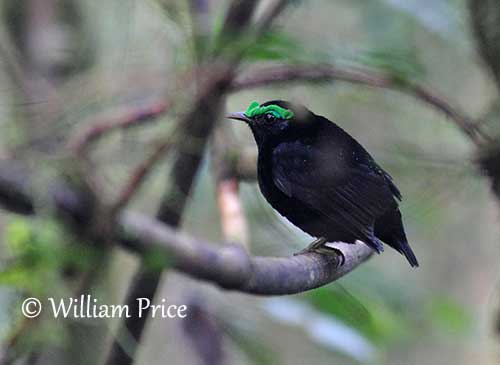
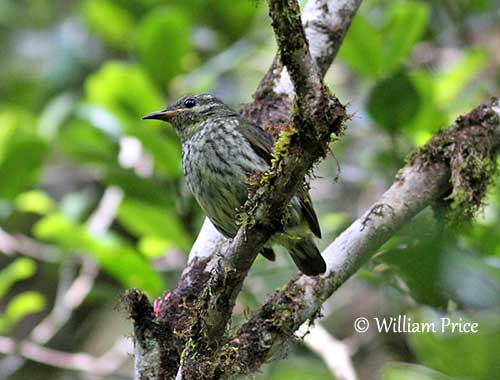
Male
Female
They live in forests, mainly rainforest but also dry deciduous forest and all are arboreal species. They can be seen from sea-level to high elevations. They feed on fruits (Philepitta) or nectar (Neodrepanis), but both genera also take insects and spiders, especially during the nesting period. They are sedentary in Madagascar, but they may move according to food resources.
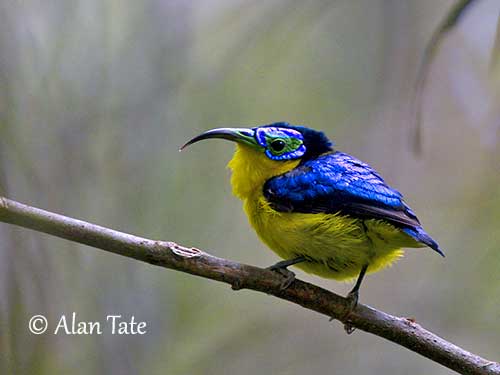
Both genera feed on insects and spiders, especially when feeding the chicks and during the cool season. They extract arthropods from under flaky bark or dead vegetation and probes wood and bark crevices. Both sunbird-asities may sally-glean and sally for insects, especially when they are in mixed-species flocks. They can be seen in small groups, probably family parties between June and September. They are always very active while feeding.
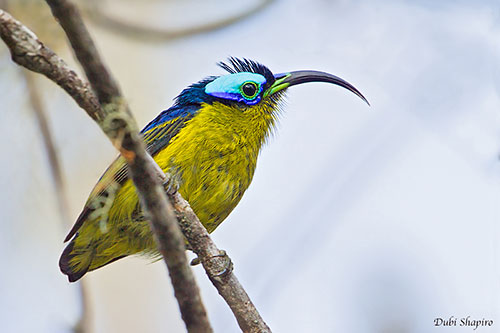
Asities have complex but interesting breeding systems, and for all species, polygyny could be possible. However, the breeding strategies are flexible and depend on resources availability.
As the males of all four species have conspicuous bright-coloured face patterns, we can suggest that they use adapted posture in order to enhance these ornaments in front of females for courting them, and towards other males or intruders as intimidation behaviour.
The breeding season of the three rainforest species with displays and nest-building takes place from September to November, with some variations from north to south of the range. This season coincides with the Malagasy rainy season. The sunbird-asities appear to have more extended season, from August to January, but with peak in October-November.
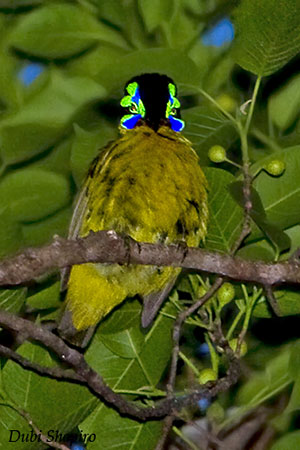
All asities build a hanging spherical or pear-shaped nest. It is often made with bamboo, roots, moss, grass, strips of bark and leaves, held together with spider webs. An entrance hole is made by poking the bill through the wall of the side of the structure, instead of weaving the hole while building the nest. Some overhanging grass shelters the entrance.
The moss is the most used material, but nest-materials may differ slightly depending on the location. The nest of the Schlegel’s Asity is mainly built from strips of bark and dead leaves, because there is little moss in the west of the island.
The nests are suspended from branches of shrubs or low trees, between 2 and 5 metres above the ground.
The clutch size is poorly documented. From some observations, the Velvet Asity lays three eggs, and two eggs were found in each nest of both sunbird-asities. Nothing is known about the clutch of the Schlegel’s Asity. Incubation and fledging periods are unknown either.
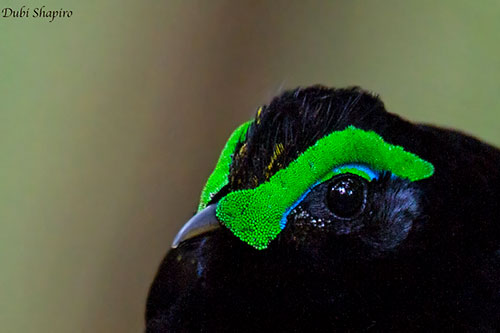
The Philepittidae are vulnerable to human activities. They largely depend on forest and are threatened by habitat loss as the forest is continuously cleared for agriculture, mining and timber. They often have fragmented range, but they occur in several protected areas such as national parks and reserves that should help their future survival.
The family Pittidae is closely related to broadbills and asities. They are small to medium-sized stocky birds with long legs, short tails and strong bills. The bright-coloured plumage displays bright blue, green, red and yellow feathers. Unlike most birds, the bright colours are mainly on the underparts and almost invisible when the wings are folded. This feature makes the birds more difficult to find and protect them against predators.
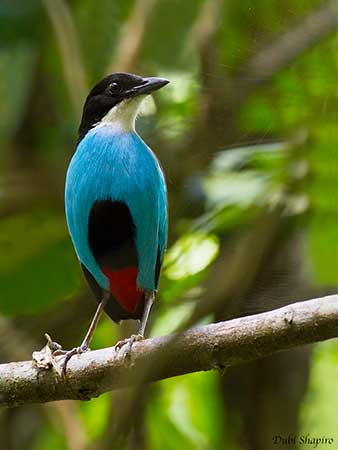

The pittas are strongly territorial and perform defence displays at territory’s boundaries. The breeding season occurs at the onset of the rainy season. They are monogamous and both parents share the nesting duties, including the nest-building.
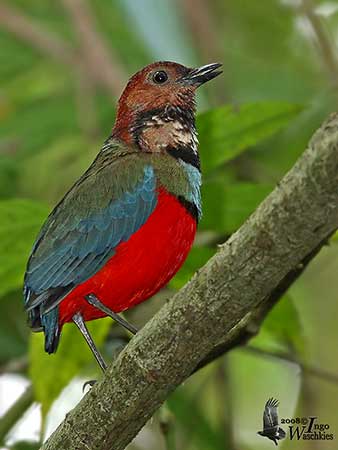
The nest is usually built on or close to the ground, two or three metres high. It is usually well-camouflaged in stump, fallen tree, roots, among vines or vegetation, banks or cliffs. It is a globular, often domed structure with a side entrance. It is made with twigs, roots and leaves, and covered in moss and leaves, making it well-protected and hidden among the vegetation. There is sometimes a platform or a kind or “doormat” at the entrance, made with sticks and sometimes decorated with mammal dung.
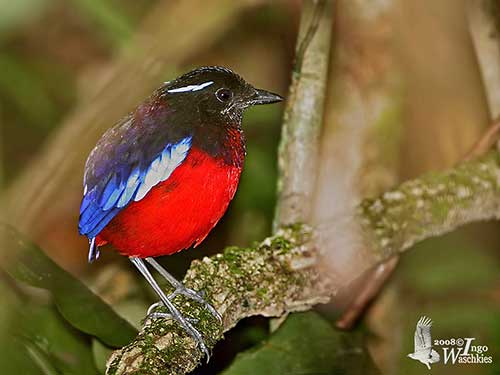
The clutch size varies according to the species and usually ranges between two and seven eggs, but there are generally three to five pale, creamy-white eggs with dark markings. Both adults incubate during 14-18 days. The chicks are fed by both parents and fledge 15-17 days after hatching. They still depend on adults for ten days.
In spite of their well-camouflaged nests, eggs and chicks are killed by snakes which are the main predators.
